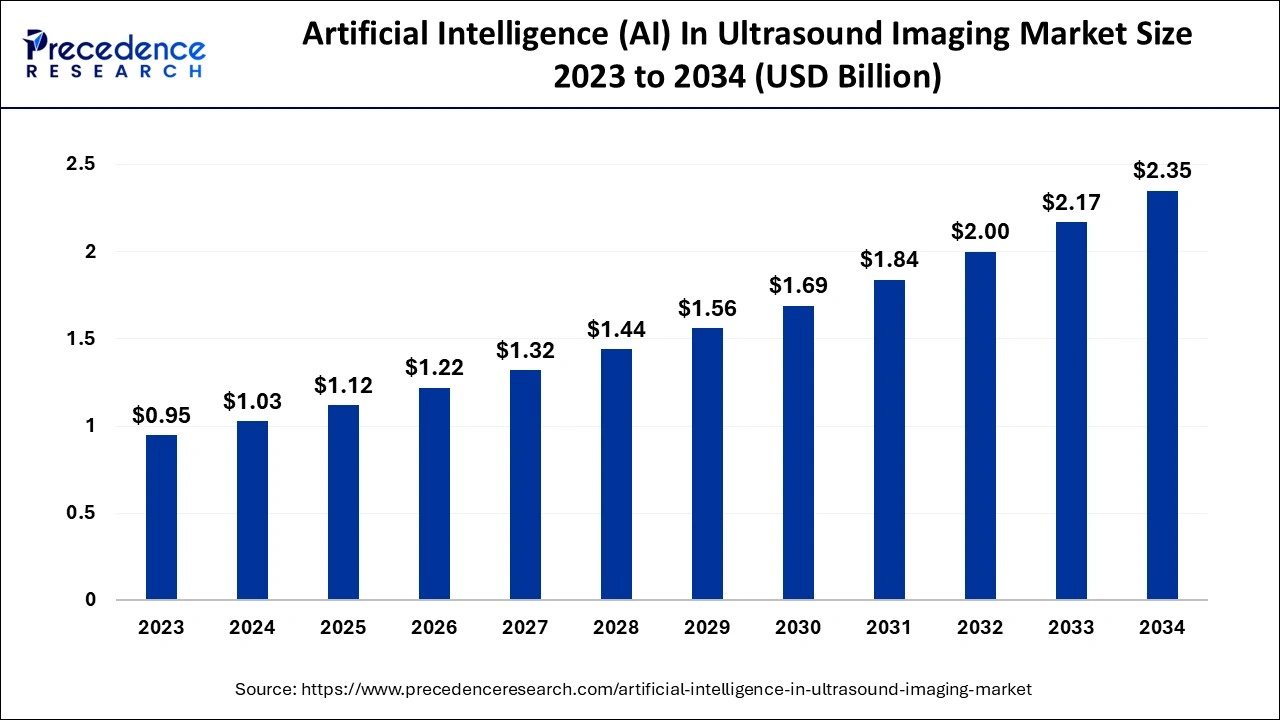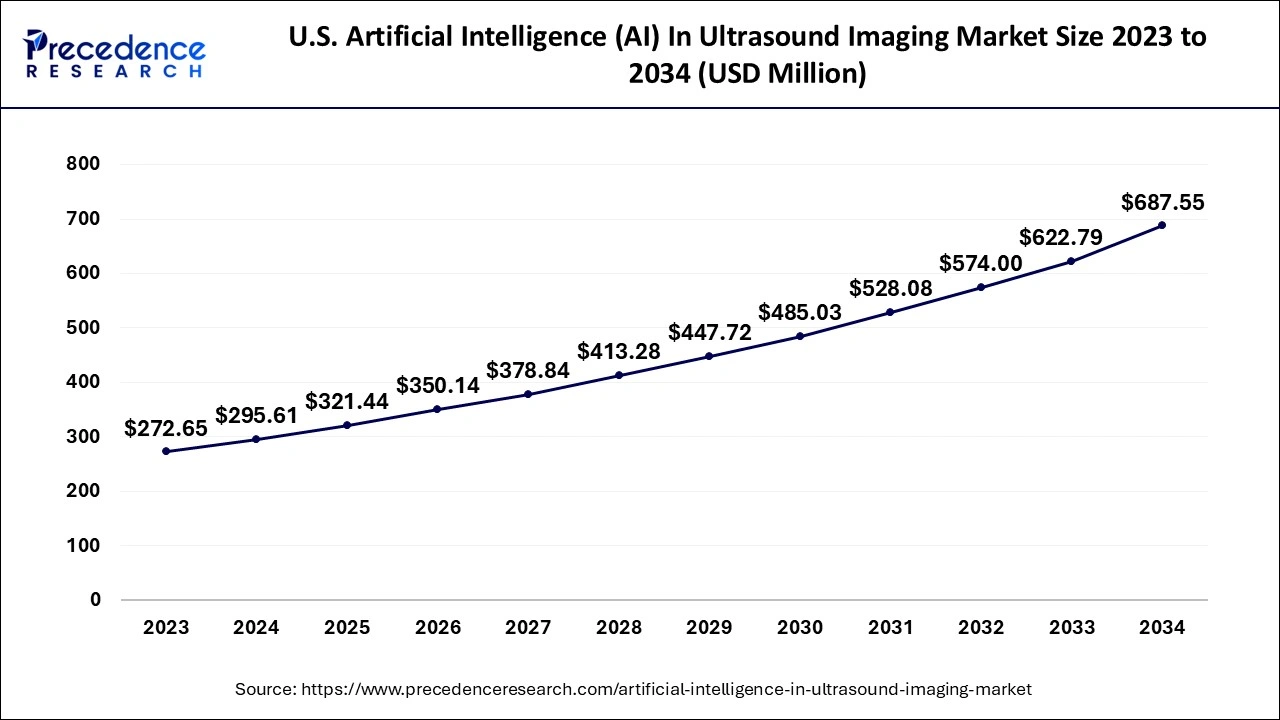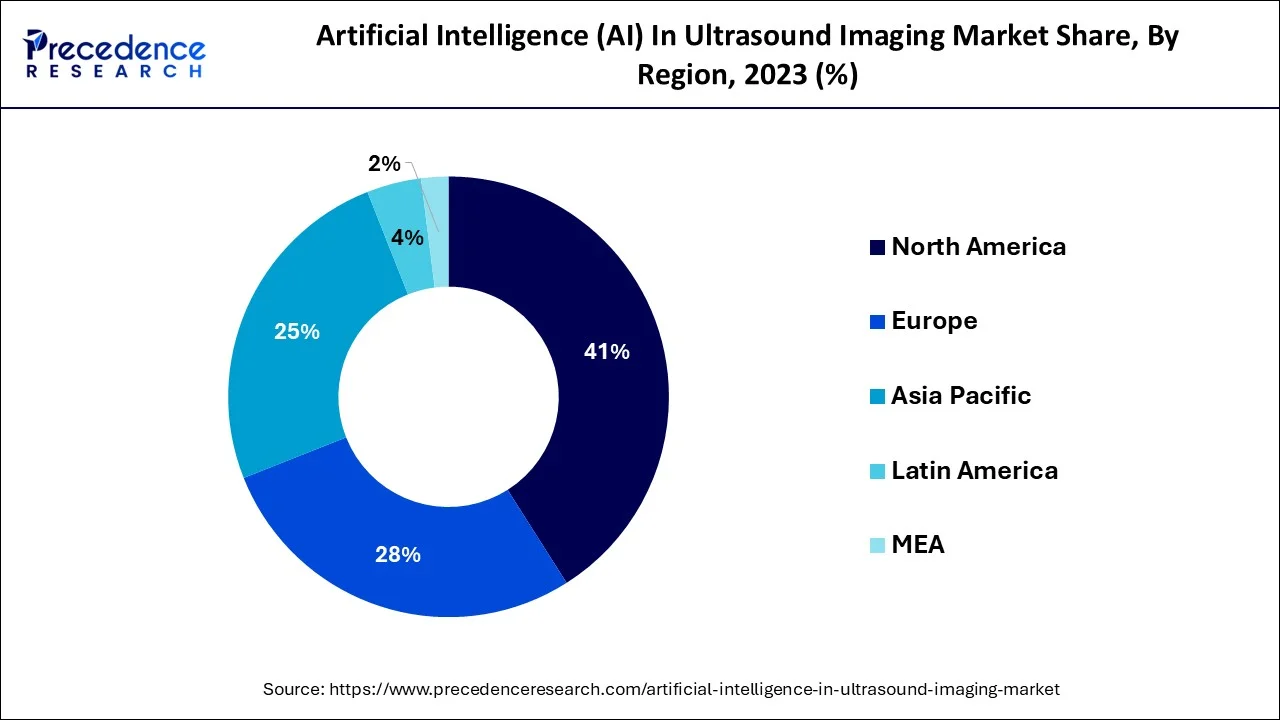August 2024
The global artificial intelligence (ai) in ultrasound imaging market size is estimated at USD 1.03 billion in 2024, grew to USD 1.12 billion in 2025 and is predicted to surpass around USD 2.35 billion by 2034, expanding at a CAGR of 8.60% between 2024 and 2034. The North America artificial intelligence (ai) in ultrasound imaging market size accounted for USD 420 billion in 2024 and is anticipated to grow at a fastest CAGR of 8.74% during the forecast year.
The global artificial intelligence (ai) in ultrasound imaging market size is estimated at USD 1.03 billion in 2024 and is predicted to surpass around USD 2.35 billion by 2034, expanding at a CAGR of 8.60% between 2024 and 2034.

The global artificial intelligence (ai) in ultrasound imaging market size accounted for USD 295.61 million in 2024 and is expected to be worth around USD 687.55 million by 2034, expanding at a CAGR of 8.90% between 2024 and 2034.

North America dominated the global AI in ultrasound imaging market in 2023. The presence of leading pharma and biotechnology companies in the region coupled with the rising investments in the adoption of the latest novel technologies in the medical sector has led to the adoption of AI in ultrasound imaging. The increased prevalence of various chronic diseases and higher healthcare expenditure has led to a higher demand for ultrasound imaging among patients. The presence of advanced healthcare facilities and better access to it has led to the dominance of North America in the global AI in the ultrasound imaging market. The rising investments in research and development and the rising investments in the adoption of the latest medical devices and software is boosting the growth of the North America AI in the ultrasound imaging market.

Asia Pacific is expected to be the fastest-growing AI in the ultrasound imaging market during the forecast period. Asia Pacific is one of the largest producers of ultrasound imaging devices at cheap costs owing to the presence of cheap factors of production. The rising prevalence of various diseases and growing demand for accurate diagnostic results is boosting the growth of AI in ultrasound imaging systems. The rising complications during pregnancy owing to late marriages and changing lifestyle of women has led to the increased demand for ultrasound imaging in obstetrics and gynecology applications. The surging government investments in the development of smart hospitals is expected to boost the growth of the Asia Pacific AI in the ultrasound imaging market during the forecast period.
The demand for ultrasound imaging is significantly high in the healthcare units like hospitals and clinics as it is considered to be one of the safest, cheapest, and most effective medical diagnostic techniques across the globe. The integration of artificial intelligence technology in ultrasound imaging is expected to make the ultrasound imaging technique smarter and improve the efficiency of the technique to accurately examine the disease. The surging demand for imaging biomarkers and quantitative imaging is significantly driving the demand for AI in ultrasound imaging.
Furthermore, the surging prevalence of various lifestyle and chronic diseases among the global population is boosting the demand for AI in ultrasound imaging to accurately diagnose the problem. As per the International Agency for Research on Cancer (IARC), in 2020, around 19.3 million new cancer cases were recorded. Around 10 million deaths were linked to cancer. The new cancer cases is expected to rise by 47% from 2020 to 2040. Moreover, around 32% of global deaths are caused due to cardiovascular diseases, as per the World Health Organization. According to the International Diabetes Federation, the total diabetic population is expected to reach around 783 million by 2045. Therefore, with the rising prevalence of chronic diseases and a growing number of hospital admissions, the pressure on hospitals is growing significantly to offer quick and effective treatment.
The introduction of AI in ultrasound imaging will help healthcare and medical service providers to quickly and accurately examine diseases and offer quick care services to patients.
| Report Coverage | Details |
| Market Size in 2023 | USD 1.03 Billion |
| Market Size by 2032 | USD 2.35 Billion |
| Growth Rate from 2023 to 2032 | CAGR of 8.60% |
| Largest Market | North America |
| Fastest Growing Market | Asia-Pacific |
| Base Year | 2023 |
| Forecast Period | 2024 to 2034 |
| Segments Covered |
|
| Regions Covered |
|
The rising inclination of health professionals towards the AI technology
The recognition of the benefits of AI-based technologies and the growing applications of AI in diagnostic activities is boosting the adoption of AI in ultrasound imaging. AI is allowing health professionals to accurately and quickly diagnose and provide results at cheaper costs. The growing pressure on the healthcare units to quickly cater to the needs of the patients while achieving increased profitability is expected to boost the growth of the AI in the ultrasound imaging market during the forecast period.
High costs of the AI based devices and software
The costs of AI-based devices and software is high. Moreover, health professionals lack the technical knowledge of operating advanced AI technologies. Therefore, the demand for third-party service providers is increasing, which is further, boosting the costs for the healthcare units. Therefore, small and medium-sized clinics and hospitals restrict themselves to adopt the AI-based ultrasound imaging devices. This may hamper the market growth.
Emerging nations is offering growth opportunities
Emerging economies like China, India, and Brazil are witnessing a rapid rise in the patient population owing to changing lifestyles and the growing prevalence of chronic diseases. The growing need for quickly and effectively providing care services to patients. This is boosting the adoption of AI in ultrasound imaging solutions. Moreover, the growing investments in the development of smart hospitals is another major driving factor of the market.
Lack of access to the healthcare and medical facilities
There is a lack of access to advanced healthcare facilities in the rural areas of developing and underdeveloped nations. The absence of proper healthcare infrastructure, high healthcare costs, and low income of the comers result in underdiagnosis and undertreatment of the patients. Therefore, the lack of healthcare infrastructure is a major challenge to the market players.
Depending on the solution, the global AI in the ultrasound imaging market was dominated by the software segment. The software is the major contributor to the revenue growth of AI in the ultrasound imaging market. It generates recurring revenues for the market players. Moreover, the software is regularly updated and it enhances the performance and accuracy of ultrasound imaging. Moreover, the rising adoption of cloud-based services and rising penetration of the internet in the healthcare sector is further fueling the demand for AI in ultrasound imaging.
Services is expected to be the fastest-growing segment during the forecast period. Operating AI-based equipment and software is a complex task and it requires specialized knowledge. There is a lack of specialized workers who can operate the AI-based technologies efficiently. Therefore, the demand for the AI services is expected to rise significantly. The healthcare professionals can focus on their core activities and the operating activities related to the AI-based hardware and software can be efficiently managed by the service providers. This will increase the pace of work and boost the efficiency and profitability of the hospitals.
Based on application, the radiology segment dominated the global AI in the ultrasound imaging market in 2023. The growth is attributed to various factors such as the surging geriatric population and the growing prevalence of chronic diseases such as cancer, cardiovascular diseases, and respiratory diseases and their survivors. The survivors of cancer are needed to monitor themselves frequently to ensure that there is no cancer cells left behind.
On the other hand, the obstetrics and gynecology segment is estimated to witness the highest CAGR during the forecast period. This can be attributed to the rising usage of ultrasound imaging during pregnancy. According to the NCBI, an average number of ultrasound imaging performed during pregnancy has spiked from 1.5 in 1995 to 2.7 in 2006, in US. The complications associated with pregnancy, reproductive system, and fertility needs to be diagnosed by ultrasound imaging. The AI in ultrasound imaging will enhance this process and boost the accuracy of the diagnosis.
Based on the end user, the hospitals segment dominated the AI in the ultrasound market in 2022. The rising government and corporate investments in the development of smart hospitals is expected to drive the growth of the hospitals segment. The hospitals require ultrasound imaging solutions as it has a huge number of patients. Moreover, the rising demand for effective and efficient diagnostic solutions in hospitals has led to the dominance of hospitals in the global market. The growing prevalence of chronic diseases and rising demand for quick and accurate diagnostic results is significantly boosting the growth of the hospital segment.
Research laboratories & diagnostic centers are expected to be the most opportunistic segment during the forecast period. The growing number of diagnostic centers across the globe especially in developing economies is expected to boost market growth significantly. The presence of a wider variety of equipment and diagnostics for various diseases is boosting the demand for medical diagnostics among patients..
Segments Covered in the Report
By Solution
By Application
By Technology
By Ultrasound Technology
By End User
By Geography
For inquiries regarding discounts, bulk purchases, or customization requests, please contact us at sales@precedenceresearch.com
No cookie-cutter, only authentic analysis – take the 1st step to become a Precedence Research client
August 2024
December 2024
September 2024
April 2025